Articles
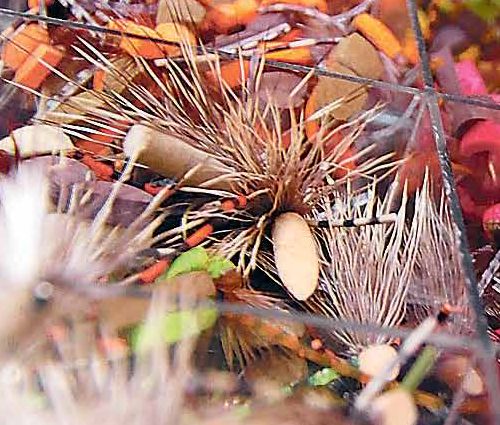 Presented from Issue 102
Presented from Issue 102
We all love the onset of summer, don’t we? Warm weather, cold beer and of course dry fly polaroiding for trout. But it’s not only the highland polaroiding that gets me excited at this time of year, because it is also closing in on hopper time on my favourite local streams.
As you wander the edge of your secret stream hotspot take a look in the long dry grass as you go, if you are kicking out a few of the resident grasshoppers then its time for a change of fly boxes. Tuck away that nymph/dry box and bring out the one loaded with big, fat foam flies. I guess you can also have some other hopper style patterns in there as well if you wish, not every fly has to have some foam in it, does it?.
- Written by Stephen Smith - Rubicon Web and Technology Training
- Parent Category: Articles
- Category: Fly Fishing
- Hits: 5998
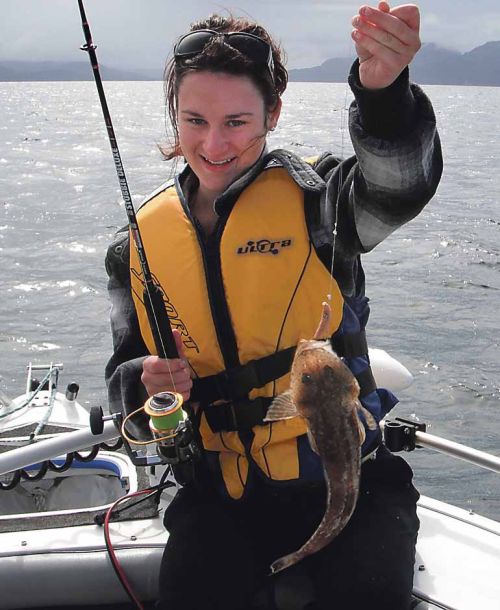 |
| Demi Lambert showing how it is done |
Presented from Issue 102
The humble Flathead is without doubt the Tasmanian anglers most sought after recreational saltwater species.
They can be found virtually anywhere there is a sandy bottom, from our estuaries to our bays, they are easy to catch and as an added bonus, are fabulous on the dinner table as well.
Mike Stevens has asked me to pen a few words together aimed at those that want to start targeting this species and perhaps aren’t really familiar on how to go about it, so here goes.
Species
There are three distinct species of flathead found around Tasmania and perhaps the most common is the southern sand flathead.
 They can grow to around 50cm in length and over 2 kg in weight, but due to them having to be around 16 years of age in order to reach this size; fish like these are the exception rather than the rule.
They can grow to around 50cm in length and over 2 kg in weight, but due to them having to be around 16 years of age in order to reach this size; fish like these are the exception rather than the rule.
Their colours vary depending on surroundings but they are usually a light brown or mottled pattern on top with a white belly.
- Written by Stephen Smith - Rubicon Web and Technology Training
- Parent Category: Articles
- Category: Saltwater and Estuary Fishing
- Hits: 14885
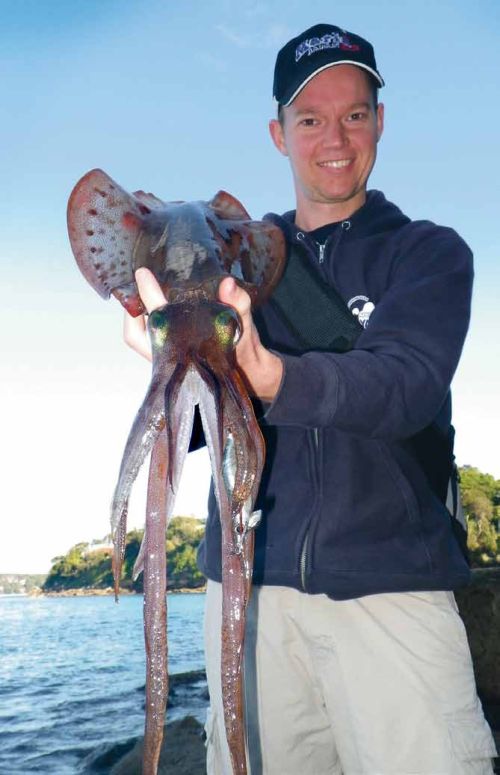 Presented from Issue 101
Presented from Issue 101
Squid fishing has become hugely popular in Tasmania in recent times and the start of spring and early summer heralds a new migration of the fish and tasty squid rings on the dinner plate. Whilst we have arrow and calamari squid in Tasmania the target species I am talking about here is calamari.
- Written by Stephen Smith - Rubicon Web and Technology Training
- Parent Category: Articles
- Category: Saltwater and Estuary Fishing
- Hits: 21474
Read more: Squid Techniques and tips for better catches - Leroy Tirant
Presented from Issue 101
Fishing with other people is an interesting experience. Fishing with someone new can be like going on a first date, while a day out with a long time mate is more like putting on a comfortable pair of old shoes. A good thing about fishing with someone else is that you get to learn by watching, which can open your mind up to new ideas and techniques.
Something else that shows through is that how personality and character can influence flyfishing style. Do you know any two people who are exactly the same? You know what it’s like. Among your friends, you might have the energetic, extroverted type, who fills in all the awkward silences, the jester, or the quiet reserved one, who doesn’t say a lot, but when they do, everyone listens (or at least should).
My own circle of fishing buddies is a diverse bunch. We do share set of values and interests - otherwise we wouldn’t be friends I guess. A common love of rivers and streams, wild trout, dry flies, and of course, total catch and release binds us. There are some basics that we all adhere to in terms of technique, but there is a lot of variation in other than key areas. We all catch our share of fish, but don’t count them, certainly not in a “I got five, he got three” type of competitive way.
Here is an insight into my fishing mates, what I’ve learnt from them, and proof that there’s more than one way to skin a trout (so to speak)!
- Written by Stephen Smith - Rubicon Web and Technology Training
- Parent Category: Articles
- Category: Trout Fishing
- Hits: 3767
Read more: Mates and Fish - Choose them carefully - Nick Taransky
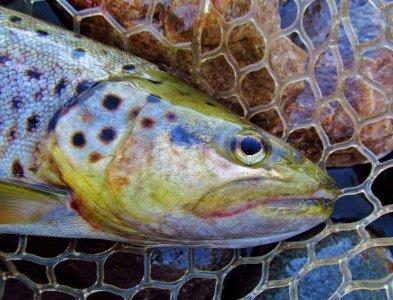 With a very light breeze blowing I was in two minds all day whether to go and have a session on the Mersey River or not. Finally around 2:30pm I decided I would go for a late spin session after all. I was in the river by 3:00 pm in what was really good conditions even though the river was running low and clear, not only that I would be fishing in full sun for the first 400 meters of river until I reached the shaded areas on the river. I started off using a hard body for a while without any sign of a trout before I changed to the gold Aglia spinner when I reached a 300 meter shallow fast water stretch of river that varied in depth from (4'' to 6'') 10cms to 20cms.
With a very light breeze blowing I was in two minds all day whether to go and have a session on the Mersey River or not. Finally around 2:30pm I decided I would go for a late spin session after all. I was in the river by 3:00 pm in what was really good conditions even though the river was running low and clear, not only that I would be fishing in full sun for the first 400 meters of river until I reached the shaded areas on the river. I started off using a hard body for a while without any sign of a trout before I changed to the gold Aglia spinner when I reached a 300 meter shallow fast water stretch of river that varied in depth from (4'' to 6'') 10cms to 20cms.
- Written by Stephen Smith - Rubicon Web and Technology Training
- Parent Category: Rivers
- Category: Mersey River
- Hits: 4144
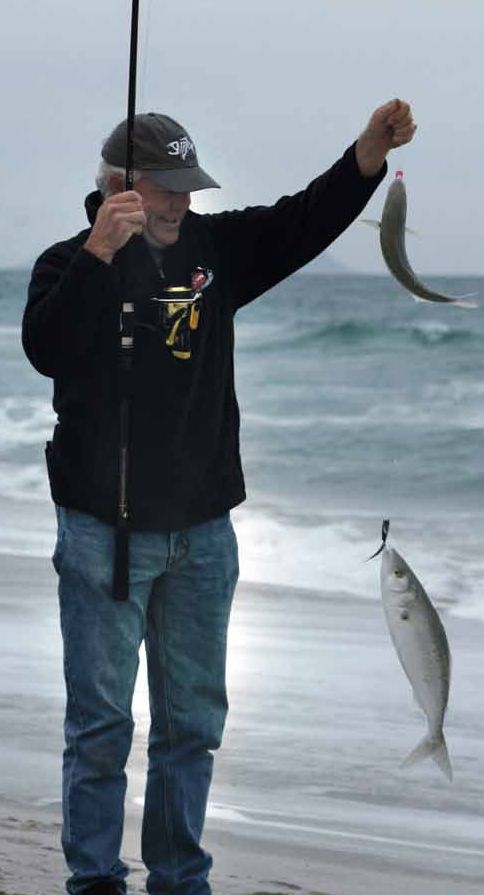 Presented from Issue 101
Presented from Issue 101
For as long as people have been coming to the East Coast of Tasmania, surf fishing its beaches has been one of the most popular pastimes. Whilst not always the most productive form of fishing it certainly is one of the most relaxing. Its something that the whole family can be involved in and I have to say its quite something to see a group of families on the beach, dads with a couple of surf rods out, wives sunbaking on the white sand in the sun and the kids either playing happily, building sandcastles or trying their hand at a bit of light surf fishing.
The chance to have a holiday on the beach, put a smile on the children’s face and wet a line at the same just can’t be overrated. Add to that the chance of putting a fresh feed of fish on the dinner table and you have wonder whether heaven could be better than this
All that is need is a basic range of gear, some comfy camp chairs , an esky full of ice, drinks and food — and of course a separate esky for the bait, sunscreen, hat and sunnies and plenty of time to relax and enjoy the atmosphere. Many of the East Coasts beaches offer very easy access and often some great free camping facilities right on the beach as well as some light rock fishing in some areas.
- Written by Stephen Smith - Rubicon Web and Technology Training
- Parent Category: Articles
- Category: Saltwater and Estuary Fishing
- Hits: 5696
Read more: Surf’s Up - Fun in the sun - and a few fish too - Jamie Henderson
 ... there's still some beauties to be caught - Adrian Webb 2017 04 13
... there's still some beauties to be caught - Adrian Webb 2017 04 13
Today I decided to have a trip to a small stream/creek in the upper reaches of Gunns Plains it's one that I haven't fished for six years. The reason I decided to check it out was because I was going back through my diaries and came across a report of one of my trips to it. I have no idea if it's has a name or not as it's one I stumbled onto one day while checking out a few back roads that crossed over small creeks & streams in the area that flow into the Leven River. It's very over grown in most sections and calls for some accurate casting.
- Written by Stephen Smith - Rubicon Web and Technology Training
- Parent Category: Rivers
- Category: Leven River
- Hits: 5624
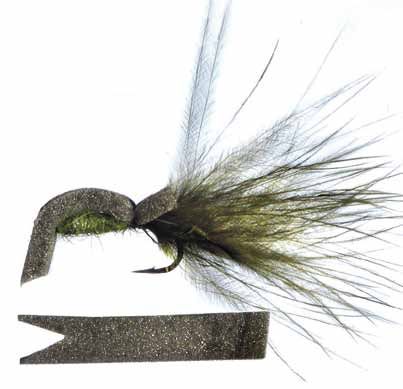 Presented from Issue 101
Presented from Issue 101
Over the last couple of months I have traveled to some of Australia’s most remote red sand country where there were fish in remote billabongs.
These are fed by the northern waters flowing into Lake Eyre Basin. To be invited onto a million acre station catching golden perch (yellow belly) and grunter was a great privilege and is another fishing adventure ticked off.
- Written by Stephen Smith - Rubicon Web and Technology Training
- Parent Category: Articles
- Category: Jan’s Flies
- Hits: 4188
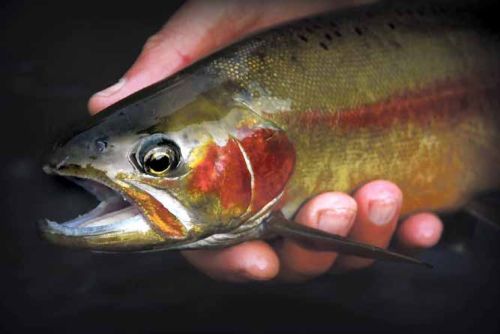 Presented from Issue 101
Presented from Issue 101
I am a fly fisher living on the banks of the Mersey River in Latrobe in northern Tasmania. Some, close to me, think I am obsessed. I get to see close hand the cycles of the river and its inhabitants throughout the changing seasons. For me the most exciting time of the trout fishing season is late spring and early summer when the aquatic insects, like the caddis flies, stoneflies and above all the majestic mayfly, are going through their hatching stages. What follows is a story of a spring morning’s fishing on my favourite stream.
- Written by Stephen Smith - Rubicon Web and Technology Training
- Parent Category: Rivers
- Category: Mersey River
- Hits: 6063
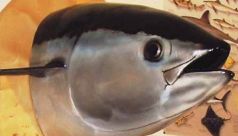 Presented from Issue 101
Presented from Issue 101
Catching the fish of a lifetime was one thing, but preserving it as a trophy was going to be another. Since the capture of the massive 147kg Southern Bluefin Tuna which we had now affectionately called ‘Charlie’, the desire to have the fish immortalised grew.
But just how do you freeze a fish head and backbone that weighed over 50 kg and measured over 2 metres long? Most of the flesh had been shared among friends, family and neighbours and in the first week alone it was calculated that over 140 people had eaten a meal from “Charlie”. Some had commented “best sashimi ever” whilst others had preferred the taste of the smaller, tastier, softer school bluefin tuna. Charlie had been grilled, fried, curried, marinated, smoked, baked, battered, mornayed, and yes…even eaten raw.
- Written by Stephen Smith - Rubicon Web and Technology Training
- Parent Category: Articles
- Category: Tuna Fishing and other Game Fishing
- Hits: 6851
Read more: Making a Trophy - 147 kg Southern bluefin tuna - Geoff Madden and John Wilesmith
Presented from Issue 101
It’s warming at last! The weather is becoming more predictable and water temperatures have accordingly risen. Along with this comes the hatches and falls of insects which bring trout to the surface. The sinking lines can be put away for a while and the excitement of top of the water fishing can take its place. Not only does static dry fly come to the fore, but also top of the water loch style techniques particularly on rougher days.
- Written by Stephen Smith - Rubicon Web and Technology Training
- Parent Category: Articles
- Category: Fly Fishing
- Hits: 7198
Subcategories
Rivers 305
Lakes 439
Events 111
Estuary Fishing 112
Other 26
Fly Fishing 67
Trout Fishing 250
Jan’s Flies 50
Cooking Fish 19
Fishing Information 29
Handy information and links to fisheries,weather etc
Fishing Books 8
Fishing books
Videos 5
Please select a video from the list below
Note: All videos use a lot of download data - please be aware of this.
Current TFBN
Click above for current issue content. The current issue of TFBN is extensive and topical. In Tackle Stores, Newsagents and by subscription.
Delivered to your door for $48 for 2 years (8 issues). To subscribe, send Mike $48 via www.paypal.com.au . (Basic instructions are here) The email is at Contact Us. Your address will be included from PayPal.
Or phone Mike with your c/c handy on 0418129949
Please ensure your details are correct, for Mike to organise delivery.
TFBN Newsletter Sign up Form
Why not submit an article ?
When you have finished for the day, why not have a brag about the ones that didn't get away! Send Mike an article on your fishing (Click here for contact details), and we'll get it published here. Have fun fishing - tasfish.com
Category Descriptions
Here is a list of all of the Article Categories. The number in Brackets, eg (13) is the number of articles. Click on Derwent River and all articles relating to the Derwent will be displayed in the central area.
Articles by Category
-
Rivers (3)
-
Saltwater and Estuary Fishing (149)
-
Kayak Fishing (34)
-
Lakes (1)
-
Great Lake (62)
-
Lake Leake (52)
-
Woods Lake (16)
-
Lake Augusta (11)
-
Huntsman Lake (13)
-
Lake Pedder and Gordon (10)
-
Lake Dulverton (5)
-
Lake Crescent (6)
-
Tooms Lake (10)
-
Lake Mackintosh (2)
-
Lake Barrington (5)
-
Little Lake (8)
-
Meadowbank Lake (5)
-
Lake King William (7)
-
Lake St Clair (2)
-
Western Lakes (12)
-
Arthurs Lake (35)
-
Lake Echo (7)
-
Four Springs (54)
-
Lake Sorell (7)
-
Lake Burbury (6)
-
Other Lakes (57)
-
Brushy Lagoon (18)
-
Little Pine Lagoon (5)
-
Penstock Lagoon (16)
-
Brumbys Creek (7)
-
-
Events (48)
-
Estuary Fishing (0)
-
Coastal Catches (46)
-
Super Trawler (46)
-
IFS, DPIPWE, MAST and Peak Bodies (435)
-
Commercial Interests (98)
-
Other (24)
-
TFBN Back Issues (8)
-
Fly Fishing (67)
-
Trout Fishing (250)
-
Meteorology and Weather (8)
-
Jan’s Flies (50)
-
Tuna Fishing and other Game Fishing (86)
-
Cooking Fish (19)
-
Fishing Information (1)
-
Fishing Books (8)
-
Videos (5)
-
Tackle, Boats and other Equipment (146)
-
World Fly Fishing Championship 2019 (2)
Popular Tags
windyty.com
Visit https://www.windyty.com/
Rubicon Web and Technology Training
Hello everyone, I thought it would be a good time to introduce myself.
My name is Stephen Smith and I have been managing the website tasfish.com since May 2009.
It has been an epic journey of learning and discovery and I am indebted to Mike Stevens for his help, support and patience.
I am developing a new venture Rubicon Web and Technology Training ( www.rwtt.com.au ). The focus is two part, to develop websites for individuals and small business and to train people to effectively use technology in their everyday lives.
Please contact me via www.rwtt.com.au/contact-me/ for further information - Stephen Smith.
From the Archives ... (last chance)
Fishing on the Wild Side
Fishing on the Wild Side
Mike Fry doesn’t only live on the Wild Side of Tasmania, but also goes fishing in probably the wildest boat ever to troll for trout—certainly in Tasmania.
When your mate says ‘What are you doing tomorrow, want to come up the Gordon for the night?’ it would be pretty hard to say anything else except “you bet” and start checking out your tackle box and packing your overnight bag. But if your mate was Troy Grining and he wanted to give his new 52ft, high speed cruiser a run across Macquarie Harbour, test the new onboard dory with a chance of landing a nice Gordon River Brown you would have to feel privileged. I didn’t say anything about getting on my hands and knees and kissing his feet…just having a lend of ya’ but I did feel very appreciative.



